Myotis muricola (Gray, 1846)
 |
| Image taken by and used with permission from Chan Kwok Wai. |
[28]
Table of Contents
| Common name(s): |
Nepalese Whiskered Bat Nepalese Whiskered Myotis Whiskered Myotis Wall-roosting mouse eared bat |
| Synonym(s): |
Myotis mystacinus (Tomes,1859) subspecies caliginosus_ Myotis mystacinus (Gray,1846) subspecies muricola Vespertilio blanfordi Dobson,1871 Vespertilio caliginosus Tomes,1859 Vespertilio muricola Hodgson,1841 [nomen nudum] Vespertilio muricola Gray,1846 |
Myotis muricola is a small, insectivorous bat common in a variety of habitats, from primary forest to moderately urbanized areas throughout South and Southeast Asia[1]. It is most well-known for roosting in rolled-up leaves of broad-leaved plants like banana, but it can also be found in caves and tree hollows[1].
In Singapore, this species is considered very common, and can be found in most habitat types except over water and in the city[2]. It typically emerges in the early evening to forage on insects that congregate around street lights[2].
Myotis muricola has a confusing taxonomic history due to sharing a number of morphological similarities with other common Southeast Asian Myotis bats, and currently it is considered a species complex by the IUCN[1]. However, its taxonomic status is still considered valid by the scientific community[36]. Myotis muricola looks very similar to Myotis mysticanus and Myotis ater and shares its range with both species in certain parts of Southeast Asia, but recent surveys and historical records have shown that only M. muricola is present in Singapore[2][8].
1. Ecology
1A. Echo-location and feeding behavior
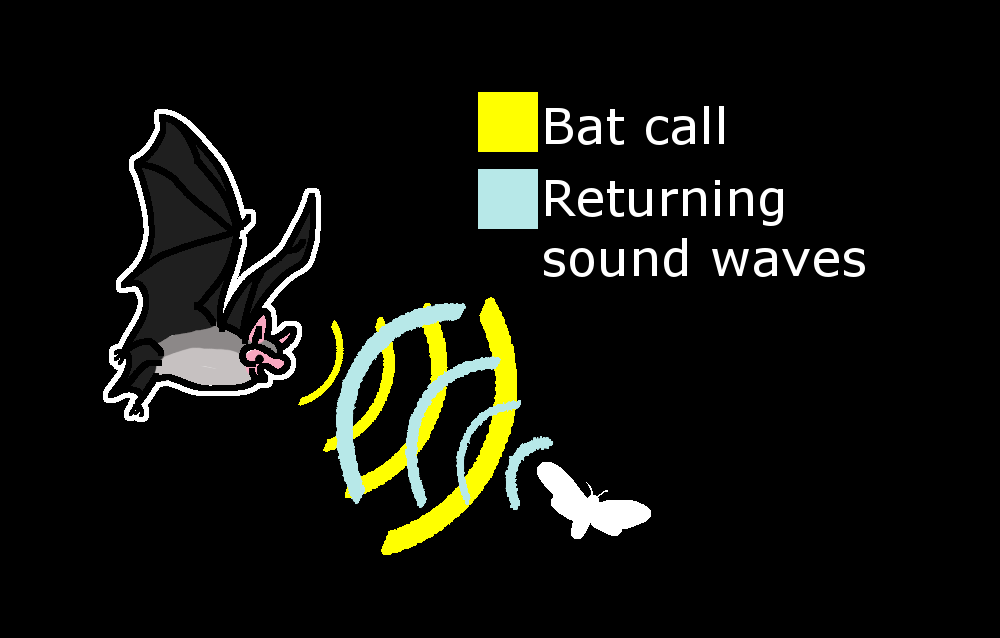 |
| Diagrammatic representation of echo-location by Jacqueline Chua, 2015. |
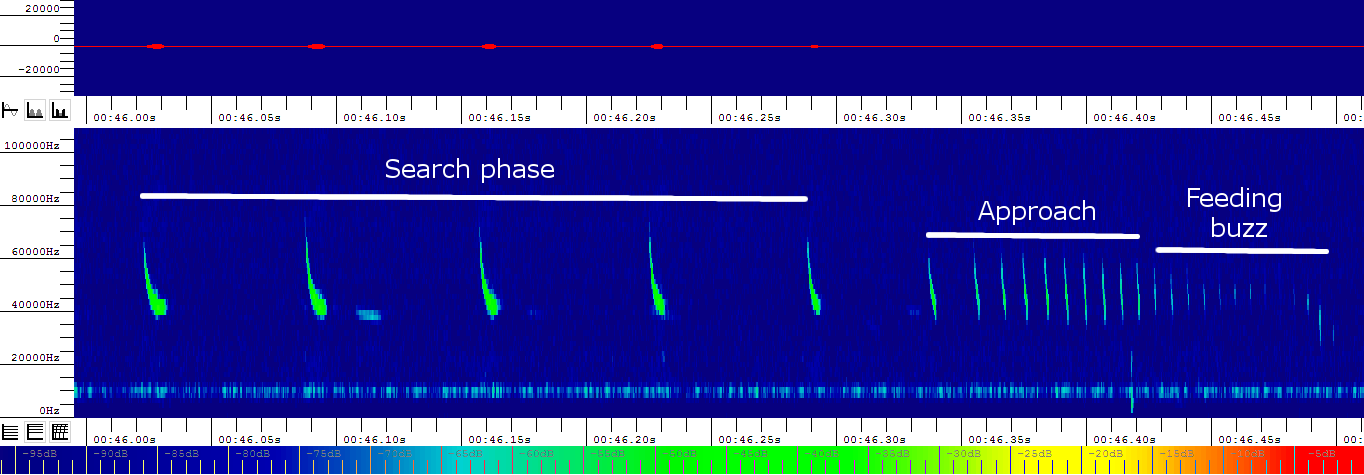 |
| Sonogram of the search, approach and feeding buzz FM call phases of an unknown bat. Image made using Songscope by Wildlife Acoustics. Edited by Jacqueline Chua, 2015. |
Bats can sometimes be identified based on their calls, but this is difficult and generally requires many different samples as one species may produce a number of different calls. The calls can take on different shapes when visualized as a sonogram, and they can be sorted into CF (Constant Frequency), FM (Frequency Modulated) or CF-FM calls[3]. CF calls tend to look like a continuous line that stays within a very small range of frequencies over a longer period of time, while an FM call looks more like a gradient over a larger range of frequencies over a shorter span of time, and a CF-FM call incorporates elements of both[3]. CF calls are normally emitted by bats that forage in open, uncluttered habitats such as fields or over water, while FM call bats tend to hunt in more enclosed and cluttered spaces such as in the forest understory[3]. Myotis muricola produces a rather unique looking CF-FM call which is roughly L-shaped, which may aid it in foraging in both cluttered and uncluttered habitats[2]. The sonogram for M. muricola can be viewed in the description section of this page.
Myotis muricola is a rather fast flyer[4][5], and can catch small, fast flying insects such as the Asian tiger mosquito directly using its mouth. Considered an 'aerial hawker', this bat has mostly been observed catching its prey on the wing[4]. Larger insects are caught by "scooping" them out of the air using the tail membrane and then flipping them into the animal's mouth. Occasionally, wing tips are also used to maneuver particularly large prey from the tail membrane to the mouth as well[6].
You can watch a similar "scooping" action of a Myotis volans bat here:
[27]
Myotis muricola is part of a large assemblage of insectivorous bats in the tropics, which all play an important role in regulating insect numbers[7]. There have been some estimates that bats prevent billions of dollars worth of damage to crops by pests annually, and that some studies estimate that a single insectivorous bat may eat up to 3,000 insects a night[7], but this varies by species and further research has to be done to determine the exact impact M. muricola has in the tropical ecosystem.
To find out more about other species of bats in Singapore and ongoing bat research in southeast Asia, please visit some of the links provided under further resources.
1B. Roosting behavior
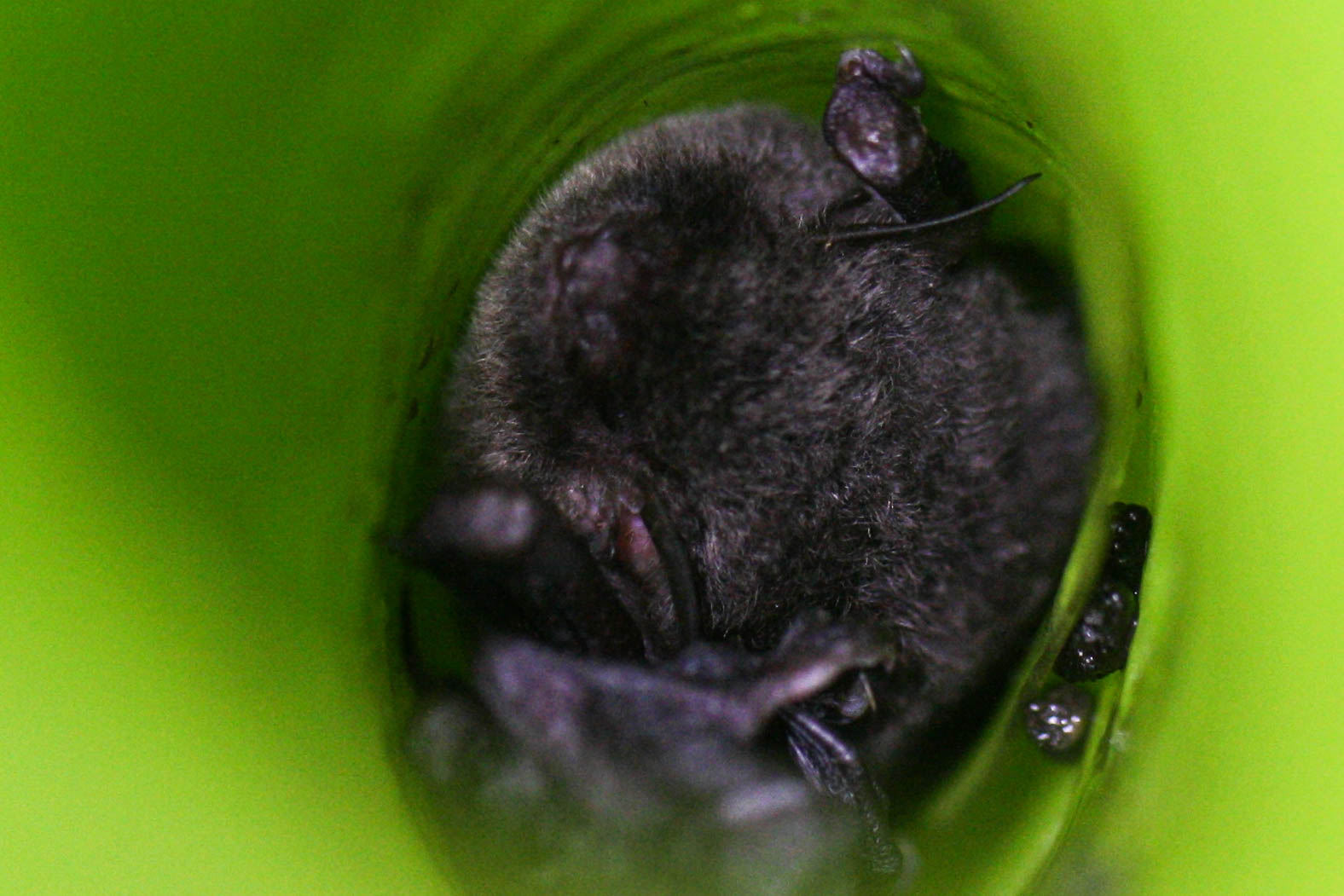 |
| M. muricola with pup roosting inside a curled banana leaf. Photo by Jacqueline Chua, 2015. |
Myotis muricola can be found either singly or in small groups in tightly curled leaves of broad-leaved plants, most commonly banana, but such roosts are highly transient as the leaf fully unfurls after a few days[6]. This species can also be found in much larger colonies in more permanent roosts such as caves and tree hollows, and even artificial structures such as mines, tunnels and old buildings[1].
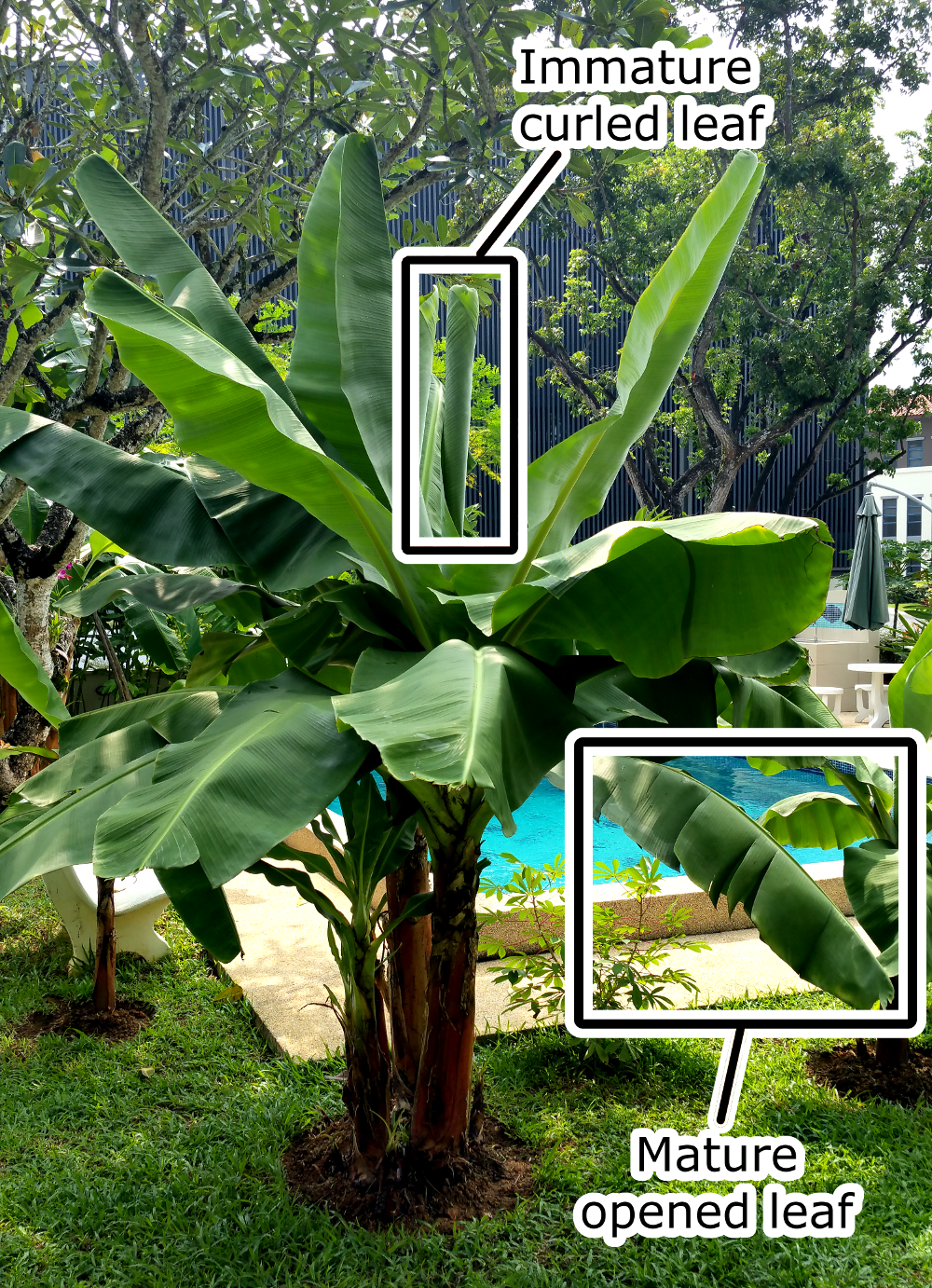 |
| Image by Jacqueline Chua, 2015. |
A number of other bats in Singapore can also be found using banana leaves as roosts[2], although they normally roost under the fully opened leaf rather than in the young curled leaves. One of the more common ones is Cynopterus brachyotis, or the lesser dog-faced fruit bat.
2. Description
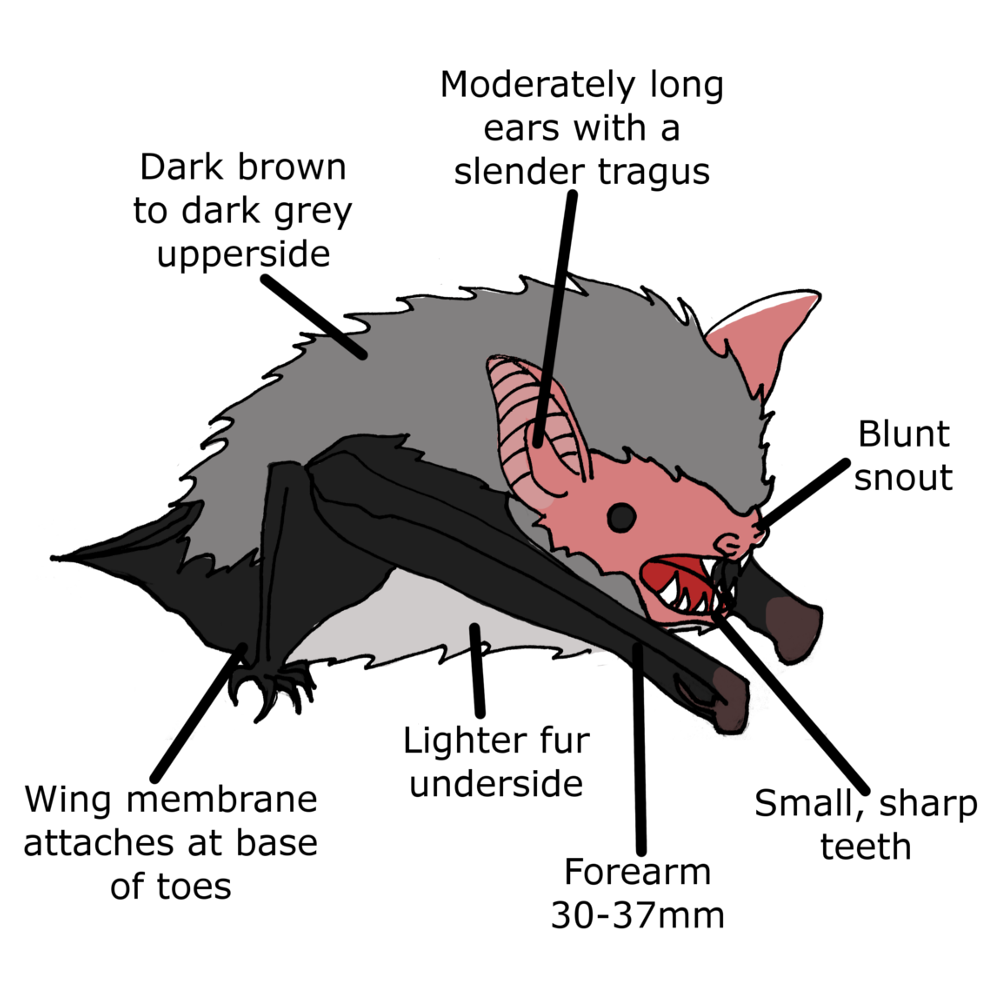 Image by Jacqueline Chua, 2015.   Brown variant image from Wikipedia and grey variant image by Nick Baker respectively. Wikipedia image taken under CC 3.0 and Nick Baker's image is used with permission.[29][37] Brown variant image from Wikipedia and grey variant image by Nick Baker respectively. Wikipedia image taken under CC 3.0 and Nick Baker's image is used with permission.[29][37] |
General distinguishing features[8]:
|
 [30] |
Distinguishing cranial features[8]:
|
  Myotis muricola skull lateral view and lower jaw lateral view respectively.Photos by Phil Myers, Museum of Zoology, University of Michigan-Ann Arbor. Image taken from Animal Diversity Web, CC 3.0[31][32] Myotis muricola skull lateral view and lower jaw lateral view respectively.Photos by Phil Myers, Museum of Zoology, University of Michigan-Ann Arbor. Image taken from Animal Diversity Web, CC 3.0[31][32] |
Distinguishing dental features: |
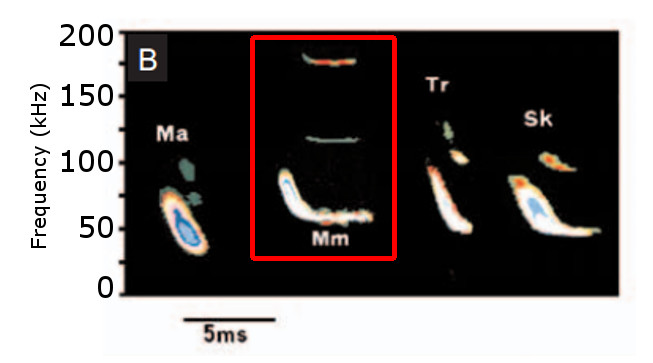 [2] |
Sonogram for search calls[2]:
|
3. Distribution
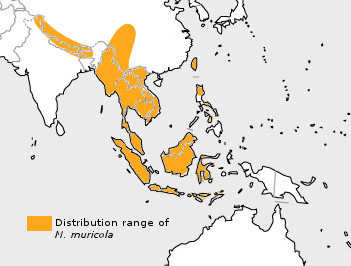 |
| Map of M. muricola's distribution. Base map by Jason Rhode on Flickr, and data derived form Global Biodiversity Information Facility. Image modification by Jacqueline Chua, 2015. |
[33][34]
Records of this bat come from as far north as Nepal and as far south as Indonesia[1]. While this species seems very widespread, this may not be entirely accurate as there has been taxonomic dispute as to whether M. muricola should be further split into more species according to geophysical regions, particularly west and east of the Wallace line[10]. This is further elaborated in the section on taxonomy.
4. Threats
 |
| The deforestation caused by slash and burn in Indonesia, by Shankar S. on Flickr. Some rights reserved. |
[35]
While the IUCN red list considers this species of be of least concern[1], small populations of M. muricola are still vulnerable to drastic land use change associated with deforestation, agriculture and urbanization. In some isolated localities such as remote islands, this species may also be threatened by the collecting of individuals for scientific research[1].
In addition, while M. muricola seems to have adapted well to Singapore's urban environment, there is still a possibility that rapid land use changes may locally endanger them[12]. Myotis muricola is not listed in the Singapore Red Data book, most likely due to its very common status[2].
However, the unresolved species complex status of M. muricola may be masking the fact that yet undescribed cryptic species within the complex may actually be endangered[38]. Research on this is still ongoing, as chromosomal studies have shown that M. muricola populations on small Indonesian islands do not mix, implying that this bat does not disperse over large bodies of water well[26]. This in turn may imply that these isolated island populations may be genetically distinct and may actually form different species, making these small isolated populations more vulnerable than previously thought.
5. Taxonomy
| Kingdom_ |
Phylum_ |
Class |
Order |
Suborder |
Family |
Genus_ |
Species |
| Animalia |
Chordata |
Mammalia_ |
Chiroptera_ |
Yangochioptera_ |
Vespertilionidae_ |
Myotis |
M. muricola_ |
5A. The genus Myotis
Myotis is the largest genus with the most extensive range in the entire order Chioptera, and is found in most terrestrial habitats, with the exception of the polar regions[15]. The genus Myotis is generally distinguished by having plesiomorphic dental formulae, with one upper incisor, one upper premolar and one lower premolar all absent, and lacking specialized cranial structures and individual tooth form[13][14]. However, while Myotis seems uniform morphologically, it has been found that there are relatively large genetic distances between species, which may be due to long periods of isolation and individual development[15]. In addition, some studies have also shown that morphological characteristics used to sort Myotis bats into subgenera are more functional than phylogenetic[16]. Thus, due to this morphological uncertainty in identifying many Myotis species in the field, many Myotis species today are actually recognized as species complexes comprising of a few cryptic species instead, as the only way to conclusively identify them is through phylogenetic means[17].
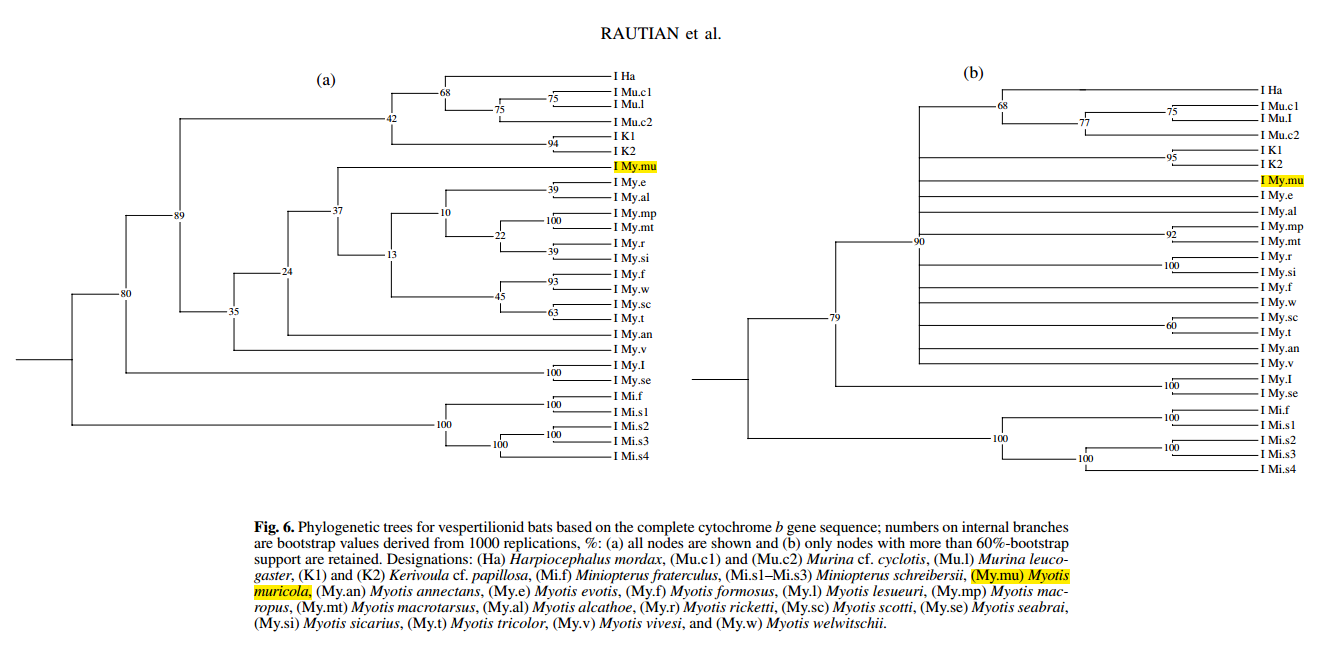 |
| Phylogenetic tree for vespertiliod bats based on the complete cytochrome b gene sequence by Rautian et al. (2006) M. muricola highlighted. |
A study by Ruedi et al. in 2013[17] managed to identify East Asia as the cradle for the evolution of the genus Myotis using sequences of the mitochondrial cytochrome b and nuclear Rag 2 genes. They hypothesize that rapid climatic changes may have triggered the extensive radiative evolution of Myotis species. Ancestral area reconstructions based on molecular phylogeny suggest that the eastern portion of the Asian continent was the origin for all Myotis lineages, which eventually spread across both the old and new world[17].
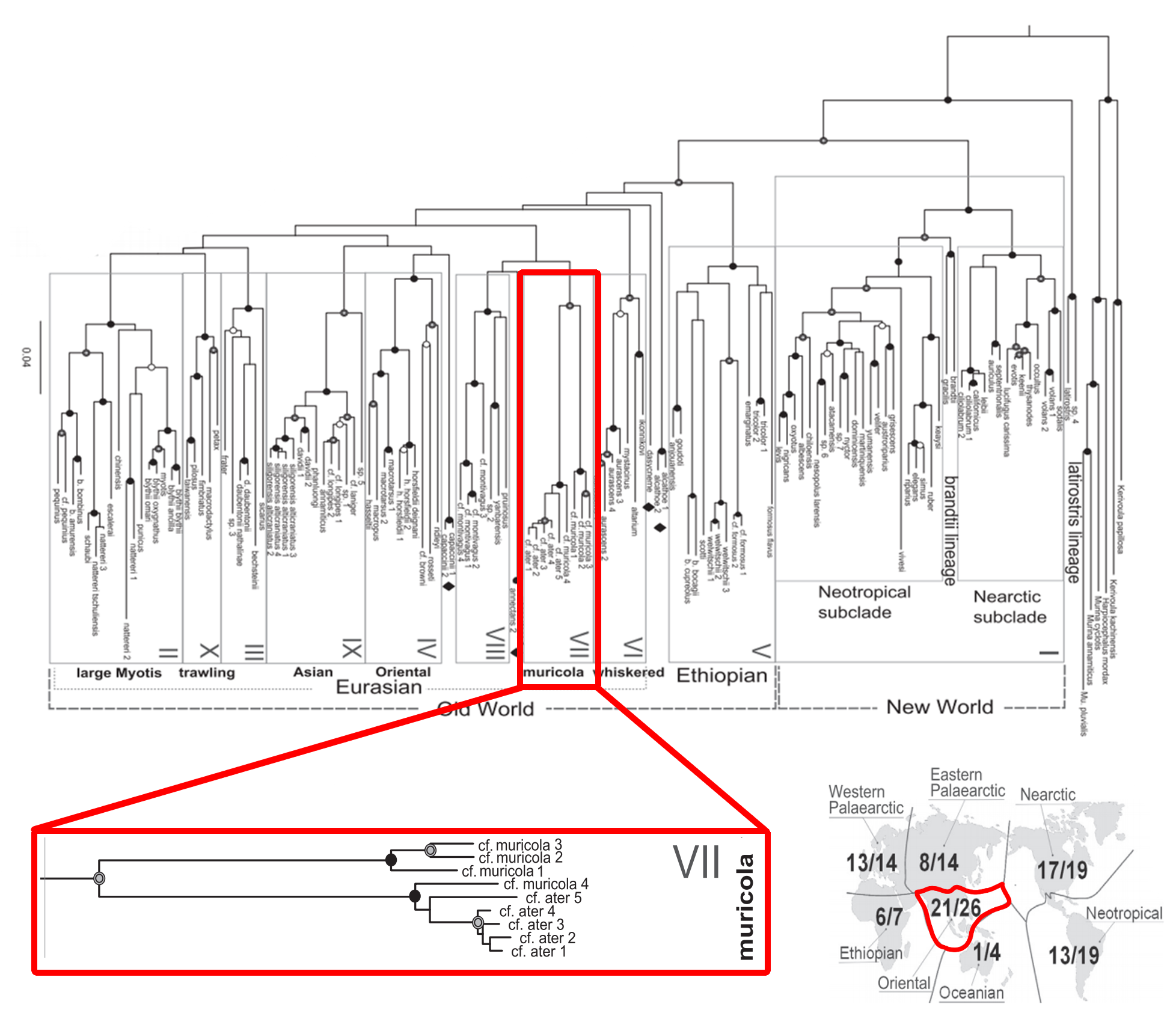 |
| Modified image of a maximum likelihood tree for 135 sequences of Myotis and six outgroup species based on analyses of the combined mitochondrial and nuclear data set (1140 bp of Cytband 1148 bp of Rag 2). Nodal support is represented as standard bootstrap value (BP) obtained with RAxML or posterior probabilities (PP) obtained with MrBayes. By Ruedi et al., 2013. |
[17]
5B. Taxonomic history of M. muricola
Myotis muricola was originally included under Myotis mystacinus by Kuhl in 1819[18] and was first cataloged separately from M. mystacinus by Hodgeson in 1814 as Vespertilio muricola (nomen nudum)[18]. Gray then officially described it under the same name in 1846[9].
The official taxonomic resolution of the M. mystacinus and M. muricola complex was by Hill in 1983[19], with rough delineations of what would later be acknowledged as subspecies within M. muricola[21].
However, due to very similar morphology, M. mystacinus and Myotis ater were often mistakenly mislabeled or grouped with M. muricola in the field[8], as it is generally difficult to differentiate many bat species by morphology alone, and often boils down to very precise measurements of limb lengths, skull lengths and dental characteristics[9][20]. Myotis mystacainus, M. ater and M. muricola are all sympatric in many areas in southeast Asia but do not have significant genetic flow between them, which is also indicative that they form separate species[8].
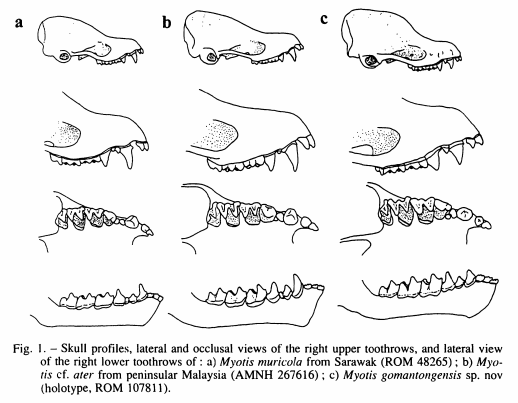 |
| Scientific illustration of defining skull characteristics between three very similar Myotis bats by Francis & Hill (1998). |
[8]
Interestingly enough, Francis and Hill also differentiated a specimen of Myotis oreias (Temmick, 1840), or the Singapore Whiskered bat, from M. muricola as a separate species, as it has longer ears and a larger body size than most M. muricola specimens[8]. This bat was supposedly endemic to Singapore, but it has not been found in any recent bat surveys and may be extinct[2]. There is quite a lot of controversy over M. oreias as only the holotype remains and is badly damaged, and there is also doubt as to whether the specimen really came from Singapore[8].
5C. Myotis muricola as a species complex
It should also be noted that species complexes are common amongst nocturnal animals, as traditionally obvious morphological features such as fur color are not as important to these animals as they are active at night[39]. Today, additional taxonomic tools are used to delineate species, such as calls and DNA. However, neither morphological nor DNA-based analysis alone can be guaranteed to identify morphologically similar bat species, so both should be used in conjunction to differentiate them[40].5D. Current phylogenetic research
| Subspecies: |
Myotis muricola browni Taylor, 1934 Myotis muricola caliginosus (Tomes, 1859) Myotis muricola herrei Taylor, 1934 Myotis muricola latirostris Kishida, 1932 Myotis muricola moupinesis (A. Milne-Edwards, 1872) Myotis muricola muricola (Gray, 1846) Myotis muricola niasensis Lyon, 1916 Myotis muricola patriciae Taylor, 1934 |
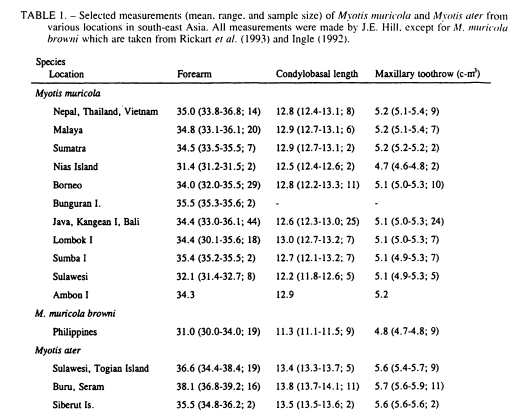 |
| Table showing the slight morphological variations between M. muricola specimens collected across Southeast Asia by Francis & Hill (1998). |
In addition, a recent study by Wiantoro et al.[11] has shown that the M. muricola may in fact consist of two separate species divided by the Wallace line. By analyzing partial mitochondrial cytochrome b sequences, the study proved that the two populations of M. muricola on the eastern and western side of the Wallace line had a high genetic distance from 26.8% to 38.5%, which is well above the 11% threshold for species recognition under the genetic species concept [25]. The Winantoro et al. study also supported the distinction of M. muricola from M. mystacinus, although they also found that the M. muricola on the western half of the Wallace line were more closely related to M. mystacinus than the M. muricola on the eastern half, although both groups of M. muricola can be considered sister taxa to M. mystacinus.
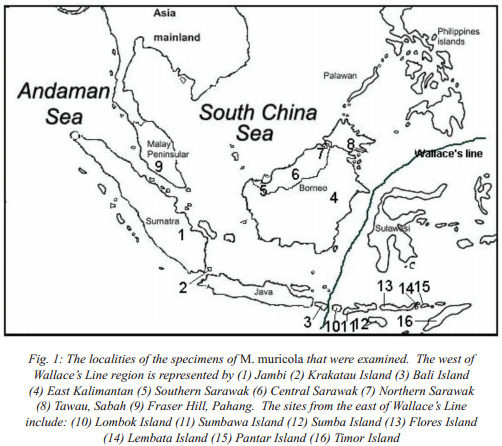 |
| Map of Southeast Asia with Wallace's line. By Wiantoro et al. (2012). |
[11]
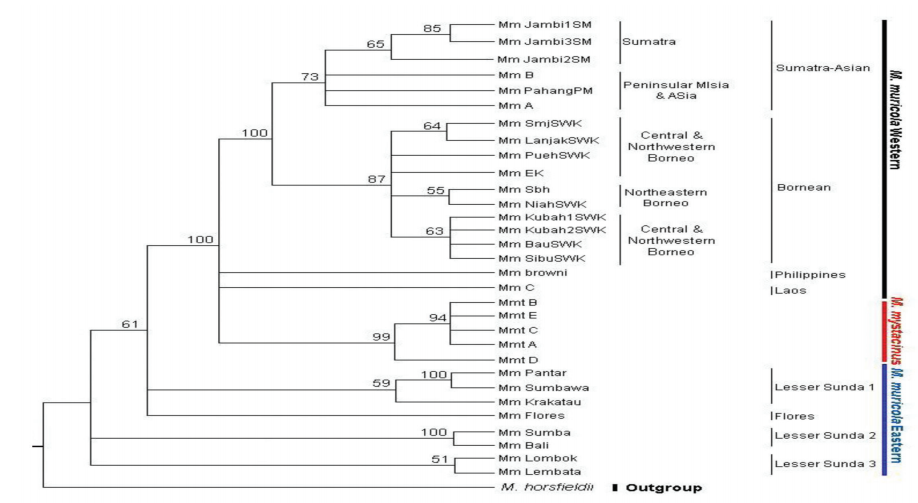 |
| The weighted and rooted Maximum parsimony (MP) tree showing the relationships between M. muricola, M. mystacinus and between the groups and subgroups within M. muricola populations based on the partial cytochrome b mtDNA. The values on the branches represent MP bootstrap values, based on 1000 replicates. Only bootstrap values >50% are shown.By Wiantoro et al. (2012). |
[11]
Furthermore, a separate study based on the chromosomal makeup of M. muricola bats found high genetic variability in populations on different Indonesian islands[26], which suggests that the island populations may be reproductively isolated, possibly because the bat is not able to cross large bodies of water between islands. Current subspecies also seem to have distinct geographic ranges, which may also allude to the inability of the bat to cross large barriers[11].
5D. Holotype and collecting data
The holotype for M. muricola is found in the Natural History Museum (London).
Collecting data:
- Type locality: Nepal
- Sex: Female
- Occurrence ID: 133f0354-fedd-4940-bcfd-7a63175d1886
- Catalog number: 1845.1.8.143
6. Further resources
6A. Other M. muricola pages
The IUCN Red List of Threatened SpeciesWhiskered Myotis - Ecology Asia
Whiskered Myotis (Myotis muricola) - Wildlife Singapore
Myotis Muricola - Southeast Asian bat Database
Global Biodiversity Information Facility
Integrated Taxonomy Information System
Encyclopedia of life
BOLD systems
Animals and Plants of Singapore
6B. Bats in Southeast Asia
Southeast Asian Bat Conservation Research unitSoutheast Asian Bat Database
Bats of Southeast Asia - Ecology Asia
A key to the bats of Southeast Asia
6C. Bat species in Singapore
Cave nectar bat (Eonycteris spelaea)Lesser dog faced fruit bat (Cynopterus brachyotis)
Lesser false vampire bat (Megaderma spasma)
7. Glossary
Condylobasal length: The length of a skull, measured from the anterior points of the premaxilla to the posterior surfaces of the occipital condyles. [Back]Condylocanine length: Distance between a line connecting the prosteriormost margins of the occipitial condyles and a line connecting the anteriormost surfaces of the upper canines. [Back]
Dental formulae: A formula for expressing the number and kinds of teeth in mammals. It is usually expressed as one of four "fractions", with one for each kind of tooth with upper and lower lines to describe the upper and lower jaws respectively. [Back]
Endemic: (of a species) native, or restricted to a certain place and is found nowhere else in the world. [Back]
Genetic distance: a measure of the genetic divergence between species or between populations within a species. Populations with many similar genes have small genetic distances, and may indicate that they are closely related and have a recent common ancestor. [Back]
Genetic species concept: The concept that a species consists of genetically compatible interbreeding natural populations that is genetically isolated from other such groups. [Back]
Holotype: The single specimen or other element used or designated as the type specimen of a species or subspecies in the original published description of the taxon. [Back]
Mitochondrial cytochrome b: A region of mitochondrial DNA that is commonly used in taxonomy to determine phylogenetic relationships between organisms. [Back]
Molecular phylogeny: A branch of phyologeny that analyses molecular differences to determine the evolutionary relationships between species. The results of such analyses are expressed as phylogenetic trees. [Back]
Morphological: The physical forms and structures present on organisms. [Back]
Nomen nudum: a term used for a name which is unavailable because it does not have a description, reference or indication. [Back]
Nuclear rag 2: A type of nuclear DNA used in taxonomic analysis. [Back]
Phylogenetic: The evolution of a genetically related group of organisms as distinguished from the development of the individual organism. [Back]
Plesiomorphic: Sharing a character trait with an ancestral clade. [Back]
Polytypic species: Having more than one variant form, i.e., having subspecies. [Back]
Radiative evolution: An increase in taxonomic diversity or morphological disparity, due to adaptive change or the opening of ecospace. [Back]
Sympatric: (of species or populations) occurring in the same or overlapping geographic areas. [Back]
Sonogram: A graph representing a sound, showing the distribution of energy at different frequencies. [Back]
Species complex: A group of close, but distinct species. [Back]
Taxonomic status: The status for whether the name of a taxon is accepted and widely used by the scientific community. [Back]
Tragus: A prominent structure on the inner side of the external ear that partly encloses the ear canal. The tragus helps bats pinpoint where their echo-locating calls are bouncing back from. [Back]
Wallace line: a faunal boundary line drawn in 1859 by the British naturalist Alfred Russel Wallace that separates the ecozones of Asia and Wallacea, a transitional zone between Asia and Australia. [Back]
8. References
[1] Bates, P.,G. Csorba, S. Bumringsri, T. Kingston, C. Francis, G. Rosell-Ambal, B. Tabaranza, L. Heaney, S. Molur, & C. Srinivasulu, 2008. Myotis muricola. The IUCN Red List of Threatened Species 2008: e.T14183A4416858.http://dx.doi.org/10.2305/IUCN.UK.2008.RLTS.T14183A4416858.en . Downloaded on 07 November 2015[2] Pottie, S., D. Lane, T. Kingston, & B. Lee, 2005. The microchiropteran bat fauna of Singapore. Acta Chiropterologica, 7(2): 237-247.
[3] Schnitzler, H., & E. Kalko, 2001. Echolocation by Insect-Eating Bats. Bioscience, 51(7): 557-557.
[4] Smith A. T. & Y. Xie (eds.), 2008. A Guide to the Mammals of China. Princeton University Press, Princeton, 576 pp.
[5] Rickarte. A., L. R. Heaney, P. D. Heideman & R. C. B. Utzurrum, 1993: The distribution and ecology of mammals on Leyte, Biliran, and Maripipi Islands, Philippines. Fieldiana Zoology, 72: 1–62.
[6] Bonaccooso, F.J. (1998). Bats of Papua New Guinea. Washington DC: Conservation International.
[7] "Rainforest Bats" by Mongabay. Mongabay, n.d.
URL: http://rainforests.mongabay.com/0409.htm (Accessed on 10 Nov 2015)
[8] Francis, C., & J. Hill, 1998. New records and a new species of Myotis (Chiroptera, Vespertilionidae) from Malaysia. Mammalia, 62: 241-252.
[9] Corbet. G. B. & J. E. Hill, 1992. The Mammals of the Indomalayan Region: A Systematic Review. Oxford, Oxford university press, 488 pp.
[10] Francis, C. M. (2008). A Field Guide to The Mammals of Southeast Asia. London, New Holland Publisher.
[11] Wiantoro, S., I. Maryanto, & M. T. Abdullah, 2012. Phylogeny and phylogeography of Myotis muricola (Gray, 1846 ) (Chiroptera: Vespertilionidae) from the West and East of Wallace’s Line inferred from partial mtDNA cytochrome b gene. Pertanika Journal of Tropical Agricultural Science, 35(2): 271-292.
[12] Lane, D. J., T. Kingston, & B. P. H. Lee, 2006. Dramatic decline in bat species richness in Singapore, with implications for Southeast Asia. Biological conservation, 131(4): 584-593.
[13] Miller, G., & G. Allen,1928. The American bats of the genera Myotis and Pizonyx. Bulletin of the United States National Museum, I-218.
[14] Rossina, V. (2003). Murinodonty As a Special Structural Type of Lower Molars of Bats. Plecotus Et Al., 6: 3-6.
[15] Rautian, G. S., V. V. Rossina, & A. S. Rautian, 2006. Approaches to the resolution of contradictions between phylogenetic reconstructions based on morphofunctional and genetic data. Paleontological Journal, 40(4) :508-523.
[16] Fenton, M. B., & W. Bogdanowicz, 2002. Relationships between external morphology and foraging behavior: bats in the genus Myotis. Canadian Journal of Zoology, 80(6): 1004-1013.
[17] Ruedi, M., B. Stadelmann, Y. Gager, E. J. Douzery, C. M. Francis, L. K. Lin, A. Guillén-Servent, & A. Cibois 2013. Molecular phylogenetic reconstructions identify East Asia as the cradle for the evolution of the cosmopolitan genus Myotis (Mammalia, Chiroptera). Molecular phylogenetics and evolution, 69(3): 437-449
[18] Ellerman, J. R., & T. C. S. Morrison-Scott, 1951. Checklist of Palaearctic and Indian mammals 1758 to 1946. order of the Trustees of the British Museum.
[19] Hill, J.E. (1983). Bats (Mammalia: Chiroptera) from Indo-Australia. Bulletin of British Natural History, Zoology, 45: 103-208
[20] Tate, G. H. H. (1941). Notes on vespertilionid bats of the subfamilies Miniopterinae, Murininae, Kerivoulinae, and Nyctophilinae. Bulletin of the AMNH, 78, article 9.
[21] Simmons, N. B. (2005). Order chiroptera. Mammal species of the world: a taxonomic and geographic reference, 1: 312-529.
[22] Stadelmann, B., L. K. Lin, T. H. Kunz, & M. Ruedi, 2007. Molecular phylogeny of New World Myotis (Chiroptera, Vespertilionidae) inferred from mitochondrial and nuclear DNA genes. Molecular phylogenetics and evolution, 43(1): 32-48.
[23] Zhang, Z., X. Tan, K. Sun, S. Liu, L. Xu, & J. Feng, 2009. Molecular systematics of the Chinese Myotis (Chiroptera, Vespertilionidae) inferred from cytochrome-b sequences. Mammalia, 73(4): 323-330.
[24] Benda, P. (2010). On a small collection of bats (Chiroptera) from western Sabah (North Borneo, East Malaysia). Vespertilio, 13(14): 45-76.
[25] Baker, R. J., & R. D. Bradley, 2006. Speciation in mammals and the Genetic Species Concept. Journal of Mammalogy, 87(4): 643-662.
[26] Hisheh, S., R. A. How, A. Suyanto, & L. H. Schmitt, 2004. Implications of contrasting of genetic variability in two vespertilionid bats from Indonesian Archipelago. Biological Journal of the Linnean Society, 83: 421-431.
[27] "Bat echolocating and catching moths" by Aaron Cocoran. Aaron Cocoran youtube channel, 23 Sep 2013.
URL: https://www.youtube.com/watch?v=MgRh_Q_xwys (accessed on 11 Nov 2015)
[28] "Whiskered Myotis" by Chan Kwok Wai. Articles page in Wildlife Singapore, n.d.
URL: http://www.wildsingapore.per.sg/fauna/pages/articles.htm (accessed on 11 Nov 2015)
[29] "Whiskered Myotis (Myotis muricola)" from Kunigen, West Java by Wibowo Djatmiko. Wikipedia, 15 June 2006.
URL: https://en.wikipedia.org/wiki/Wall-roosting_mouse-eared_bat#/media/File:Myoti_murico_060615_7419_cklpa.jpg (accessed 11 Nov 2015).
[30] "Myotis Muricola skull dorsal view" by Phil Myers. Animal Diversity web, 11 Aug 2011.
URL: http://animaldiversity.org/accounts/Myotis_muricola/specimens/collections/contributors/phil_myers/ADW_mammals/specimens/Chiroptera/Vespertilionidae/Myotis_muricula/dorsal5706/ (accessed 11 Nov 2015).
[31] "Myotis Muricola skull lateral view" by Phil Myers.Animal Diversity web, 11 Aug 2011.
URL: http://animaldiversity.org/accounts/Myotis_muricola/specimens/collections/contributors/phil_myers/ADW_mammals/specimens/Chiroptera/Vespertilionidae/Myotis_muricula/lateral5707/ (accessed 11 Nov 2015).
[32] "Myotis Muricola lower jaw lateral view" by Phil Myers.Animal Diversity web, 11 Aug 2011.
URL: http://animaldiversity.org/accounts/Myotis_muricola/specimens/collections/contributors/phil_myers/ADW_mammals/specimens/Chiroptera/Vespertilionidae/Myotis_muricula/lower_lateral5709/ (accessed 11 Nov 2015).
[33] "Blank world map" by Jason Rhode. Flickr, 15 Sept 2007.
URL: https://www.flickr.com/photos/jrhode/1386593088/ (accessed on 11 Nov 2015)
[34] "Myotis muricola" data from the Global Biodiversity Information Facility.
URL: http://www.gbif.org/species/2432429 (accessed on 11 Nov 2015)
[35] "More slash- and burn- deforestation- this time with smokin' gun evidence" by Shankar S. Flickr, April 2004.
URL: https://www.flickr.com/photos/shankaronline/14601822591/in/photolist-ofja8V-9KcYu6-bGir1t-7DZSK7-7DW3s4-9KcYba-7DW3pa-cdL7jL-9KcYhP-9KcYw2-9KfNoL-9KfMUN-9KfN7C-9KfMWh-9KcYEg-9KcYK8-9KfNjm-9KcYRz-9KcYVv-8pX2XV-9ANiEG-9ANtyQ-9AMuW5-9AMvq5-9AJD3R-9AJAUv-9AMvZW-9ANpUL-9AMxuG-9AKtfk-9AMxcY-9ALVi6-9Kg44A-9Kdegr-9APS5Y-9ALYNK-9ANqXL-9ANv8y-9AMuNu-9ALZDp-9AMx7d-9AJBqz-9AKuqk-9AMwbf-8pX5ki-AkXi1U-iyF6D2-dRdC4w-dR84i2-oKasez (accessed on 11 Nov 2015)
[36] "Myotis Muricola (Gray 1846)" by the Integrated Taxonomy Information System, n.d.
URL: http://www.itis.gov/servlet/SingleRpt/SingleRpt?search_topic=TSN&search_value=632034 (accessed 11 Nov 2015).
[37] "Roosting colony in a rolled up banana leaf, Bintan island, Riau archipelago, Indonesia" by Nick Backer.
URL: http://www.ecologyasia.com/images-vwx/whiskered-myotis_40002.jpg
[38] Arlettaz, R., 1999. Habitat selection as a major resource partitioning mechanism between the two sympatric sibling bat species Myotis myotis and Myotis blythii. Journal of Animal Ecology, 68: 460-471
[39] Jones, G., 1997. Acoustic signals and speciation: the roles of natural and sexual selection in the evolution of cryptic species. Advances in the Study of Behavior, 26: 317–354
[40] Mayer, F. & O. Helversen, 2001. Cryptic diversity in European Bats. The Royal Society, 268, 1825–1832